How to Plant an Apple Tree: Everything You Need to Know
- February 6, 2024
- 0 comment
Master how to plant an apple tree with our comprehensive guide. Learn everything you need for a thriving, fruitful tree. Planting an apple tree is not just an investment in your garden’s aesthetics but a step toward sustainable living. The joy of harvesting your own apples, whether for a crunchy snack or a homemade pie, begins with understanding the basics of apple tree cultivation. This guide is designed to equip you with everything you need to know to plant, grow, and care for your apple tree, ensuring bountiful harvests for years to come.
List of Guides on How to Plant an Apple Tree
- Step 1: Choose the Right Variety
- Step 2: Select a Planting Site
- Step 3: Prepare the Soil
- Step 4: Planting the Tree
- Step 5: Watering
- Step 6: Staking
- Step 7: Pruning
- Step 8: Pest and Disease Management
- Step 9: Fertilization
What is an Apple Tree?
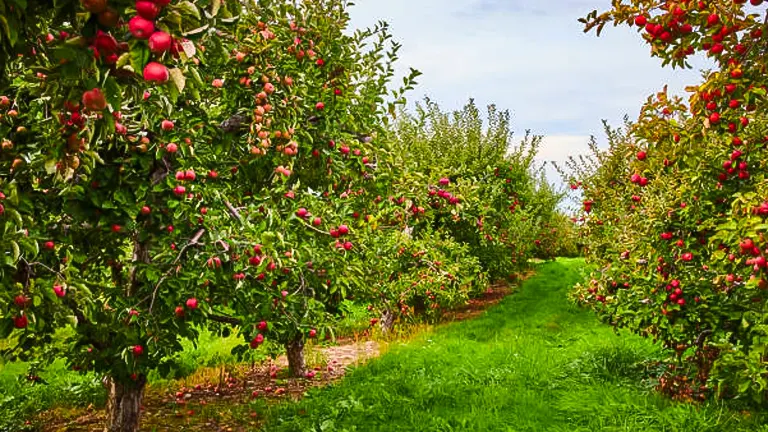
An apple tree, scientifically known as Malus domestica, is a deciduous tree in the Rosaceae family, renowned for its sweet, edible fruits. Originating in Central Asia, apple trees thrive in temperate climates worldwide and have been cultivated for thousands of years, leading to the development of over 7,500 varieties. These trees vary in size and shape based on the rootstock and variety, ranging from dwarf to standard sizes, making them suitable for a wide range of garden spaces. Apple trees are also valued for their spring blossoms, which not only add beauty to the landscape but are crucial for pollination and fruit production. With proper care, including annual pruning and pest management, apple trees can produce fruit for decades, offering not just nutritional value but also a connection to the rhythms of the natural world.
Choosing the Right Apple Tree
Types of Apple Trees
Apple trees come in three main sizes: dwarf, semi-dwarf, and standard. Your choice will depend on your space and the care you can provide. Dwarf varieties are ideal for smaller spaces and can even be grown in containers, semi-dwarfs offer a balance of manageable size and fruit abundance, while standard trees require more space and yield the largest harvests. Here’s a list of some common types of apple trees, each with its own unique characteristics:
1. Honeycrisp
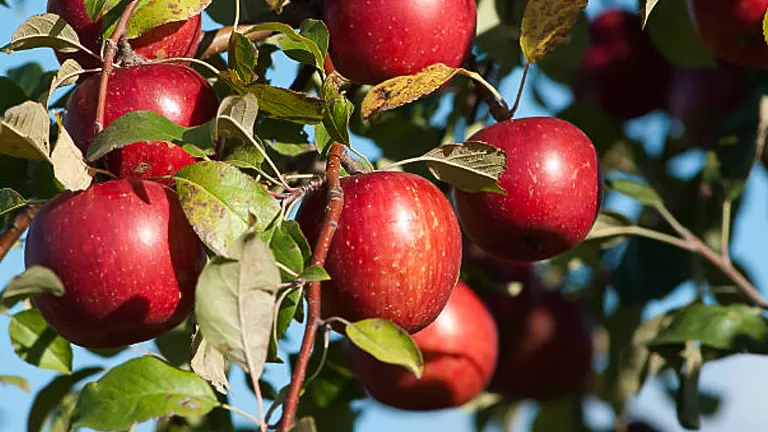
Honeycrisp apples are highly sought after for their perfect balance of sweetness and tartness, making them ideal for both fresh eating and cooking. Developed at the University of Minnesota, this variety is known for its crisp texture and juiciness. Honeycrisp trees are cold-hardy, making them suitable for growers in cooler climates. However, they require careful management as they can be prone to certain diseases and may need thorough pruning and pest control to maintain health and productivity.
- Specifications: This variety requires cross-pollination for optimal fruit production, ideally with varieties such as ‘Cripps Pink’ or ‘Golden Delicious’. It is susceptible to diseases like apple scab and fire blight, necessitating proactive management. The trees can grow to a height of about 12-15 feet (3.6-4.5 meters) in maturity and perform best in USDA zones 3-7.
2. Granny Smith
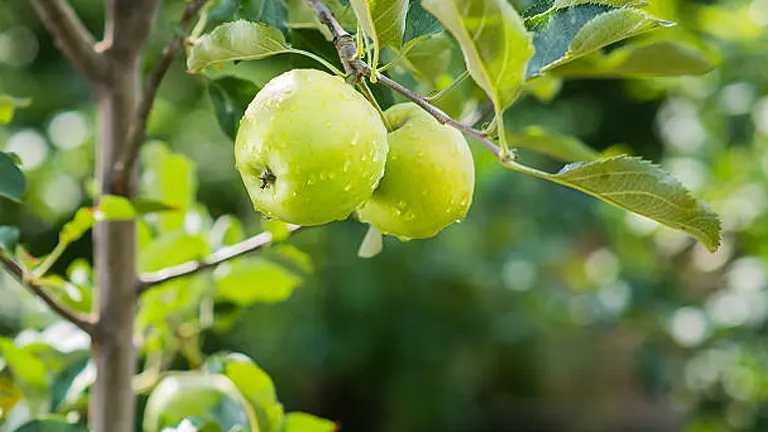
Granny Smith, originating from Australia, is famous for its bright green skin and tart flavor. This variety is incredibly versatile, widely used in baking, cooking, and fresh eating. Granny Smith trees are robust and adaptable to a variety of soil types, thriving in both warm and cool climates. They are also known for their late harvest season, providing fresh apples late into the fall when many other varieties have already been picked.
- Specifications: They thrive in a variety of soil types but prefer well-drained soil. The trees are vigorous and can grow up to 12-20 feet (3.6-6 meters) tall, suitable for USDA zones 5-9. Granny Smith requires cross-pollination with varieties like ‘Fuji’, ‘Gala’, or ‘Red Delicious’.
3. Gala
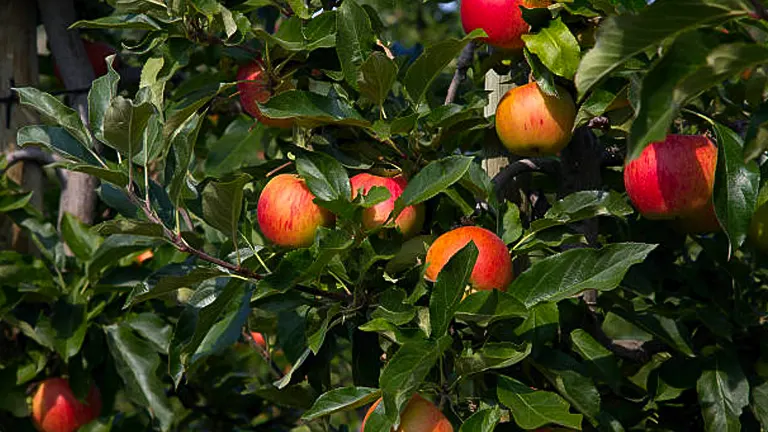
Gala apples are known for their sweet flavor, firm texture, and attractive red-striped or fully red appearance. Originating from New Zealand, this variety has gained popularity worldwide for its adaptability to different growing conditions and consistent quality. Gala trees are relatively easy to grow and can produce fruit at a young age, making them a favorite among both commercial growers and home gardeners. They are best suited for fresh eating and salads.
- Specifications: Gala trees are compact and manageable, making them ideal for smaller gardens. They reach a height of about 10-15 feet (3-4.5 meters) and are hardy in USDA zones 4-9. While they can self-pollinate, their fruit set benefits from being near varieties like ‘Honeycrisp’ or ‘Granny Smith’.
4. Fuji
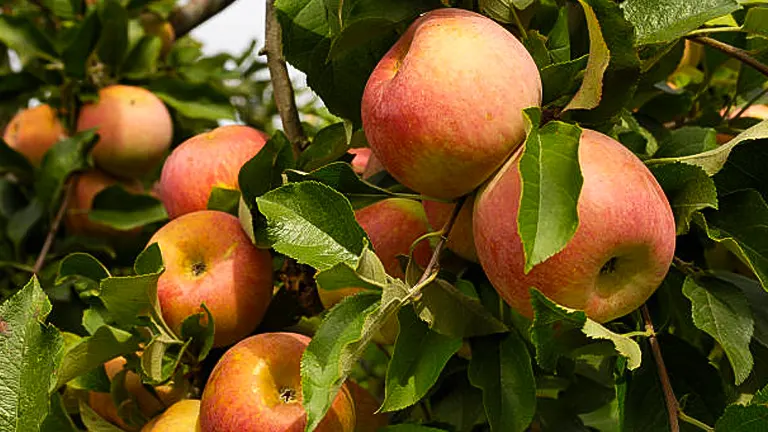
Fuji apples, developed in Japan but named after the famous Mount Fuji, are loved for their super sweet flavor and incredibly dense flesh, making them excellent for fresh eating. These apples store exceptionally well, often improving in flavor after several months of storage. Fuji trees are vigorous growers and can adapt to a wide range of climates, although they do best in warmer growing zones. They are also relatively resistant to many apple tree diseases, making them a good choice for organic growers.
- Specifications: The trees can grow up to 15-20 feet (4.5-6 meters) tall and are best suited to USDA zones 4-9. They prefer full sun and well-drained soil. Fuji apples benefit from cross-pollination with varieties like ‘Gala’ or ‘Golden Delicious’.
5. McIntosh
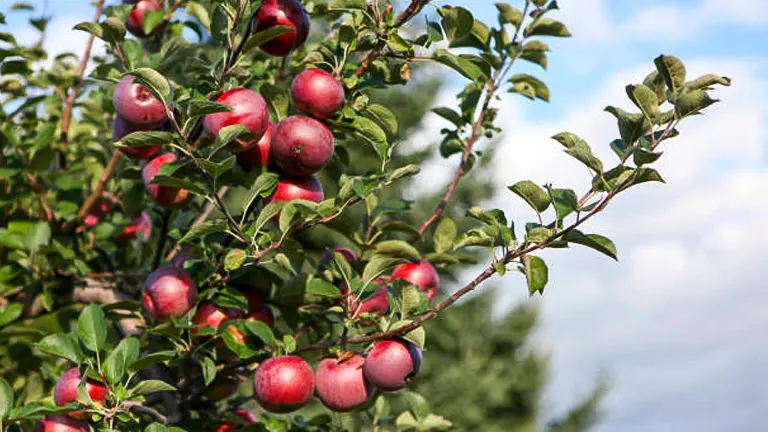
McIntosh apples are classic, with a red with green skin and a distinctly tangy-tart flavor with a hint of spice. This variety is particularly cold-hardy, originating from Eastern Canada, making it well-suited for northern climates. McIntosh trees bloom early and their apples are typically ready for harvest in late September. The fruit is best used for eating fresh or for sauces, as it tends to become soft when cooked. McIntosh trees are known for their vigorous growth and heavy bearing potential.
- Specifications: McIntosh trees are cold-hardy, suitable for USDA zones 4-8, and can reach a height of 12-15 feet (3.6-4.5 meters). They bloom early in the spring and are susceptible to both apple scab and fire blight. Cross-pollination is recommended with varieties like ‘Golden Delicious’ or ‘Empire’.
6. Braeburn

Braeburn apples have a unique combination of sweet and tart flavors, with a firm, crisp texture that makes them excellent for both fresh eating and cooking. Originating from New Zealand, this variety is notable for its coloration, which varies from orange to red over a yellow background. Braeburn trees are adaptable to a range of climates, but they require a long growing season to mature their fruit. They are also prone to biennial bearing, where heavy crop years alternate with light or no crop years, necessitating careful management of tree health and fruit thinning.
- Specifications: These trees are suitable for USDA zones 5-8 and can grow to about 10-20 feet (3-6 meters) tall. They require a long growing season and are prone to biennial bearing. Cross-pollination partners include ‘Fuji’, ‘Gala’, and ‘Golden Delicious’.
7. Golden Delicious

Golden Delicious apples are known for their all-around versatility and sweet, mild flavor. They have beautiful golden-yellow skin and are excellent for eating fresh, baking, and making cider. This variety is self-fertile, which means it does not require a pollinator tree to produce fruit, making it an ideal choice for smaller gardens. Golden Delicious trees are hardy and adaptable, but they do best in areas with warm summers and cool winters.
- Specifications: The trees are self-fertile, which makes them a good choice for gardeners with limited space for multiple trees. They can grow up to 10-15 feet (3-4.5 meters) tall and are adaptable to a range of soil types, thriving in USDA zones 4-8. However, they are susceptible to pests due to their sweet fruit.
Climate and Soil Requirements
Apple trees thrive in areas with cold winters and moderate summer temperatures. Most varieties require a certain number of chill hours to bear fruit. Soil should be well-draining, rich in organic matter, with a pH between 6.0 and 7.0. Conduct a soil test to ensure your chosen site meets these requirements.
Pollination Needs
Most apple trees need a pollinator to produce fruit, meaning you’ll need to plant two compatible varieties close to each other. Some varieties are self-pollinating, but even these benefit from having another tree nearby to increase yield.
How to Plant an Apple Tree
Step 1: Choose the Right Variety
Select an apple tree variety that suits your climate and soil conditions. Consider factors like chill hours (the number of hours below 45°F/7°C), disease resistance, and whether the variety needs a pollinator to produce fruit.
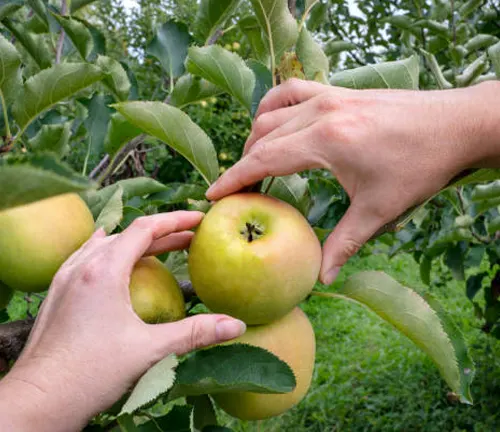
Additional Tip: If space is limited, consider dwarf or semi-dwarf varieties, which are easier to manage and can be grown in containers.
Step 2: Select a Planting Site
Choose a location that receives at least 6-8 hours of direct sunlight daily and has well-draining soil. Avoid low areas where frost can settle and areas that are too shaded.
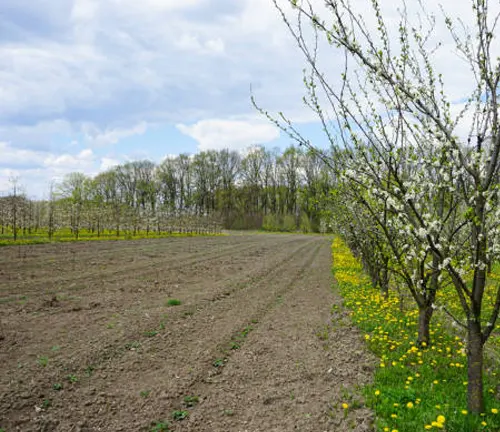
Additional Tip: Apple trees prefer a pH between 6.0 and 7.0. Conduct a soil test and amend the soil as necessary before planting.
Step 3: Prepare the Soil
Loosen the soil in a wide area around where you will plant the tree, incorporating organic matter such as compost to improve soil structure and fertility.
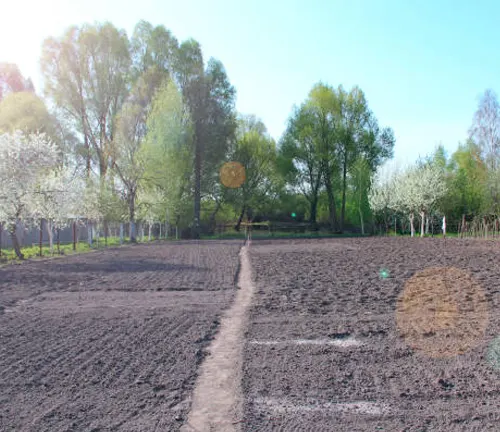
Additional Tip: If your soil is heavy clay or too sandy, consider raised beds or thoroughly amend the soil with organic matter to improve its texture and nutrient content.
Step 4: Planting the Tree
Plant your apple tree in the early spring or late fall when the tree is dormant. Dig a hole twice as wide and as deep as the root ball. Position the tree so that the graft union (visible as a bump on the trunk) is about 2 inches above the soil level. Fill the hole with soil, gently tamping down to remove air pockets, and water thoroughly.

Additional Tip: If planting a bare-root tree, soak the roots in water for a few hours before planting. Spread the roots out in the hole to encourage outward growth.
Step 5: Watering
Water the newly planted tree deeply to settle the soil around the roots. Maintain consistent moisture, especially during the first growing season, to support healthy root development.
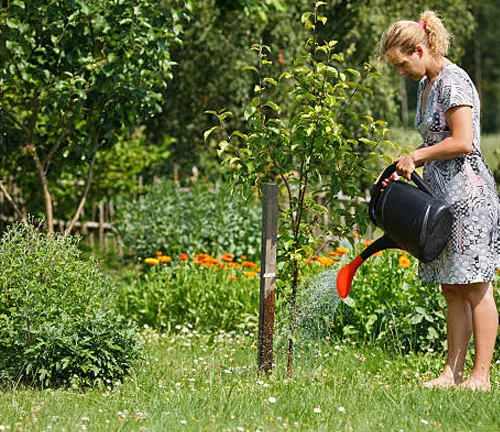
Additional Tip: Mulching around the base of the tree can help retain soil moisture, regulate soil temperature, and reduce weed competition. Keep the mulch a few inches away from the trunk to prevent rot.
Step 6: Staking
If your tree is tall, in a windy area, or has a weak root system, staking may be necessary during the first year or two to provide support.

Additional Tip: Use soft materials or tree ties to attach the tree to the stake, allowing some movement. This helps the tree develop a stronger trunk.
Step 7: Pruning
Prune the tree at planting time to balance the top with the root system, cutting back the central leader slightly to encourage strong lateral branches. In subsequent years, prune in late winter to remove dead or crowded branches and shape the tree.

Additional Tip: Keep the tree’s center open to sunlight and air circulation, which reduces the risk of disease and promotes even fruit ripening.
Step 8: Pest and Disease Management
Monitor for pests and diseases, using appropriate control measures as needed. Implementing an integrated pest management (IPM) approach can minimize the need for chemical interventions.

Additional Tip: Encourage beneficial insects and birds that prey on apple pests by planting a diverse range of plants around your orchard or garden.
Step 9: Fertilization
After the first year, apply a balanced fertilizer early in the spring before new growth begins, based on soil test recommendations.
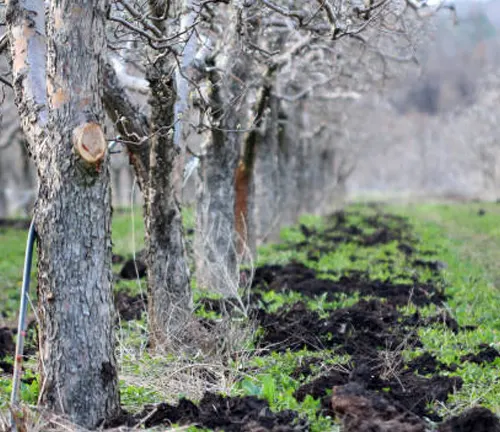
Additional Tip: Avoid over-fertilizing, which can lead to excessive leaf growth at the expense of fruit production and increase susceptibility to pests and diseases.
When to Plant
The best time to plant apple trees is in late winter or early spring, after the ground thaws but before new growth starts. In warmer climates, you can also plant in late fall, allowing roots to establish before the heat of summer.
Planting Process
- Remove the tree from its container or packaging, gently loosen the roots, and trim any damaged ones.
- Place the tree in the hole so that the root collar (where the roots meet the trunk) is level with the soil surface.
- Backfill the hole with a mix of native soil and compost, tamping down gently to remove air pockets.
- Water thoroughly to settle the soil around the roots.
- Mulch around the base of the tree to retain moisture and regulate soil temperature, keeping the mulch a few inches away from the trunk to prevent rot.
Caring for Your Apple Tree
After successfully planting your apple tree, ongoing care is crucial for its growth, health, and productivity. Here’s how to nurture your tree through its developmental stages and ensure abundant harvests.
Fertilizing
- Initial Feeding: Wait until your apple tree shows signs of new growth before applying any fertilizer. Over-fertilizing can harm young trees.
- Routine Fertilization: In subsequent years, fertilize in early spring before new growth begins. Use a balanced fertilizer (e.g., 10-10-10) at the rate recommended on the package for the age and size of your tree.
- Organic Options: For those preferring organic gardening, well-composted manure or a specifically formulated organic fertilizer for fruit trees can be excellent choices.
Pruning
- Why Prune: Pruning is vital for encouraging a strong tree structure, removing dead or diseased wood, and improving air circulation and sunlight penetration, which are crucial for fruit quality and disease prevention.
- When to Prune: Late winter, while the tree is still dormant, is the best time for major pruning. Light pruning and removal of dead wood can be done at any time.
- How to Prune: Focus on creating an open center or modified central leader shape, which allows light and air to reach all parts of the tree. Always make clean cuts close to a bud or branching point.
Pest and Disease Management
- Regular Monitoring: Keep an eye on your tree for signs of pests or diseases. Early detection is key to effective management.
- Integrated Pest Management (IPM): Use a combination of cultural, physical, biological, and chemical practices to manage pests and diseases with minimal environmental impact.
- Natural Remedies and Preventatives: Introduce beneficial insects for natural pest control, use neem oil for fungal diseases, and practice good sanitation by removing fallen fruit and leaves, which can harbor pests and diseases.
Harvesting and Storage
When to Harvest?

The timing for harvesting apples can vary significantly depending on the variety and local climate conditions. Here’s a general guide presented in a column table format to help you determine when different types of apple trees are typically ready for harvest. This guide assumes a temperate Northern Hemisphere climate; adjustments may be needed for other regions.
| Apple Variety | Typical Harvest Time | Notes |
|---|---|---|
| McIntosh | Early to Mid-September | McIntosh apples are among the first to ripen; they have a tender flesh and a tart flavor. Ideal for eating fresh and making applesauce. |
| Gala | Early September | Gala apples are sweet with a fine texture. They are great for snacking and salads due to their early harvest time. |
| Honeycrisp | Mid to Late September | Known for their crispness and juicy flavor, Honeycrisp apples are a favorite for fresh eating. |
| Golden Delicious | Late September to Early October | Versatile for both eating fresh and cooking, Golden Delicious apples have a rich, sweet flavor. |
| Fuji | Mid to Late October | Fuji apples are one of the sweetest varieties, ideal for fresh eating. They store very well, maintaining quality for months. |
| Granny Smith | Late October to November | Granny Smith apples are tart and crisp. They are favored for baking and also retain their texture and flavor well when stored. |
| Braeburn | Late October to November | Braeburn apples offer a good balance of sweet and tart, with a firm texture making them excellent for a variety of uses, including baking and fresh eating. |
Additional Notes:
- Climate Impact: The harvest times can shift earlier or later depending on your local climate. Warmer regions may see earlier harvests, while cooler areas might have a delayed season.
- Checking for Ripeness: Besides the calendar, check apples for ripeness by noting their color, ease of picking (a ripe apple should come off the branch easily with a twist), and taste. Seeds of ripe apples are usually dark brown.
- Staggered Harvesting: Some varieties may ripen over a period of weeks. It’s often best to harvest apples in stages, selecting only those fruits that are ready.
- Storage: Most apples will store well in a cool, humid place, with some varieties like Fuji and Golden Delicious maintaining quality for several months under ideal conditions.
- Signs of Ripeness: Apples are ready to harvest when they’ve reached their full color, the seeds are dark brown, and the fruit comes off the branch with a slight twist. Taste testing a few apples can also be a good indicator of ripeness.
- Timing: Harvest times vary depending on the variety, typically ranging from late summer to early fall. Keep a record of harvest times for your specific tree for future reference.
Remember, these are general guidelines. The specific timing for your trees may vary based on local conditions and the specific characteristics of your apple variety. Observing your trees and learning from each year’s harvest will help you fine-tune your picking schedule.
How to Store Apples
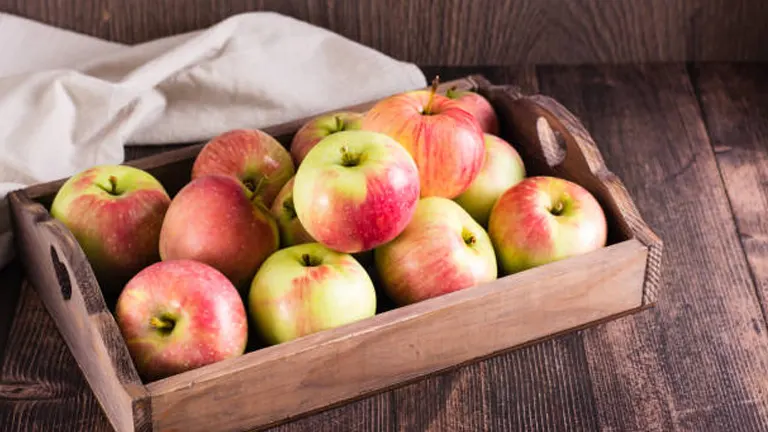
- Sort Before Storing: Begin by inspecting your apples carefully. It’s crucial to remove any apples that are bruised, have cuts, or show signs of rotting. These imperfect fruits can release ethylene gas, which accelerates ripening and can lead to spoilage of the surrounding apples. Sorting ensures that only the healthiest apples are stored, prolonging their shelf life.
- Cool and Humid Conditions: Apples are best preserved in environments that are both cool and humid. The optimal temperature for storing apples is around 32°F (0°C), with a humidity level of 90-95%. Such conditions prevent apples from losing moisture and becoming shriveled. For small quantities, the crisper drawer of a refrigerator is ideal. For storing larger quantities, consider using a cellar, insulated garage, or a specialized fruit storage cooler, especially in regions with cold winter climates.
- Use Plastic Bags: When placing apples in the refrigerator, it’s beneficial to store them in perforated plastic bags. The perforations allow for air circulation, while the bag itself helps to retain enough moisture around the apples to keep them crisp. This method also minimizes the apples’ exposure to ethylene gas produced by other fruits and vegetables in the refrigerator, which can hasten ripening.
- Separate from Strong-Smelling Foods: Apples tend to absorb odors, so it’s important to store them away from strong-smelling foods like onions or garlic. This is especially relevant if you’re storing them in a refrigerator or a cellar where such foods might also be present. Keeping apples separate ensures they maintain their natural flavor.
- Check Regularly: During storage, make it a habit to regularly check the apples for any signs of spoilage such as soft spots, mold, or unusual odors. Removing spoiled apples promptly can prevent the spread of rot to healthy fruits. This is particularly important for apples stored in bulk, where a single decaying apple can affect others in close proximity.
- Wrap Individually for Long-Term Storage: For extended storage periods, consider wrapping each apple individually in newspaper or kraft paper. This method is especially useful if you’re storing apples in boxes or bins. The wrapping provides a barrier that minimizes the risk of bruising and helps to contain any spoilage, protecting the surrounding apples.
- Store Different Varieties Separately: Some apple varieties last longer than others. For example, thick-skinned varieties like Fuji and Granny Smith tend to have a longer shelf life compared to thinner-skinned varieties like McIntosh. Storing different varieties separately allows you to manage their storage conditions more effectively and use them in an order that minimizes waste.
Conclusion
In summary, successfully planting and nurturing an apple tree is a rewarding process that requires careful selection, proper planting, and diligent care. By following the guidelines outlined in this guide, gardeners can look forward to the joy of harvesting their own delicious apples for years to come. Whether you’re a seasoned horticulturist or a budding green thumb, the journey from planting to picking is a fulfilling experience that connects you to the cycles of nature and provides the sweetest of rewards.
FAQs
- Do I need more than one apple tree for pollination?
Most apple varieties require cross-pollination from a different apple variety to bear fruit. However, self-pollinating varieties like ‘Golden Delicious’ and ‘Granny Smith’ can fruit on their own, but even these benefit from having a pollinator nearby to increase yield. - What’s the ideal location for planting an apple tree?
Choose a location with full sun (at least 6 hours of direct sunlight daily), well-draining soil, and away from low spots where frost can settle. The soil should be slightly acidic to neutral (pH 6.0-7.0). - When is the best time to plant an apple tree?
Plant during the dormant period in late winter or early spring after the ground has thawed but before new growth starts. In warmer climates, late fall planting is also beneficial. - How often should I water my newly planted apple tree?
Water the tree deeply once a week to help establish roots. Adjust frequency based on weather conditions; more during hot, dry periods, and less if there’s ample rainfall. - How do I select the right apple tree variety for my area?
Consider your climate, especially winter chill hours and summer heat, when choosing a variety. Local cooperative extensions or nurseries can recommend varieties that thrive in your area. - Can I grow an apple tree in a container?
Yes, dwarf apple varieties are well-suited for container gardening. Ensure the container is large enough to accommodate root growth and has good drainage. - What soil preparation is needed before planting an apple tree?
Amend the planting area with organic matter to improve soil structure and fertility. Ensure the site has good drainage and, if necessary, adjust the soil pH based on a soil test. - How do I protect my young apple tree from pests and diseases?
Regular monitoring, proper pruning for air circulation, and cleanliness around the tree base help prevent issues. Use appropriate organic or chemical treatments as needed, based on specific pest or disease threats.
Planting an apple tree is a straightforward yet immensely rewarding endeavor that brings beauty and bounty to your garden. With the right selection, proper care, and a bit of patience, you can enjoy the fruits of your labor for years to come. Follow these guidelines, and you’re on your way to harvesting your own delicious apples right from the backyard. Happy gardening!

Benjamin Brooks
Forestry AuthorGreetings! I'm Benjamin Brooks, and my journey over the past 15 years has revolved around the fascinating realms of content creation, expertise in snow clearing, and the intricate world of lumberjacking and landscaping. What began as a simple curiosity about the natural world and heavy machinery has evolved into a passionate profession where my love for crafting words intertwines seamlessly with my lumberjacking and garden skills.


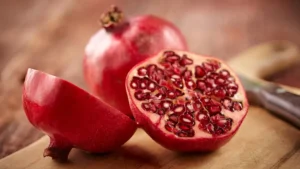










Leave your comment